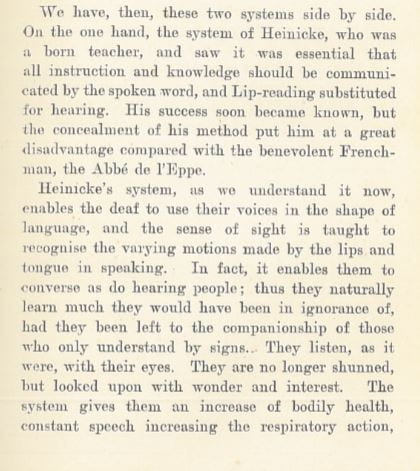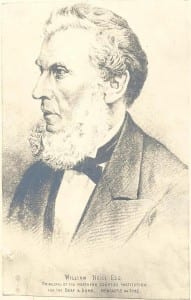“they lose the dull heavy look of a deaf mute…” – Oralist supporter, the Lip-reading teacher, Eliza Frances Boultbee
By H Dominic W Stiles, on 16 August 2019
 Eliza Frances Boultbee (1860-1925) was the daughter of Marian and James Boultbee. At the time of her birth in Staffordshire, her father was a curate, and in the 1861 census they were staying with her grandfather Thomas Boultbee, who was Vicar of Bidford, Warwickshire. James Boultbee became Vicar of Wrangthorn, Leeds, from 1866-1908. Eliza’s younger sister, Anne Gertrude Boultbee (1867-87) was born deaf, and according to the Boultbee family history website, she was taught to lip-read by Eliza. Presumably this was how she developed her interest in deaf education and oralism. This is where I hit myself on the forehead, for I have come across the name Boultbee before, though I could not recall the context. Annie Boultbee was a pupil of the oralist teacher John Barber, at his Edgeware Road school in 1881, who I wrote about exactly one year ago!
Eliza Frances Boultbee (1860-1925) was the daughter of Marian and James Boultbee. At the time of her birth in Staffordshire, her father was a curate, and in the 1861 census they were staying with her grandfather Thomas Boultbee, who was Vicar of Bidford, Warwickshire. James Boultbee became Vicar of Wrangthorn, Leeds, from 1866-1908. Eliza’s younger sister, Anne Gertrude Boultbee (1867-87) was born deaf, and according to the Boultbee family history website, she was taught to lip-read by Eliza. Presumably this was how she developed her interest in deaf education and oralism. This is where I hit myself on the forehead, for I have come across the name Boultbee before, though I could not recall the context. Annie Boultbee was a pupil of the oralist teacher John Barber, at his Edgeware Road school in 1881, who I wrote about exactly one year ago!
In the introduction of her book Practical lip-reading for the use of the deaf (1902), summarising the history of deaf education through the ages (the familiar litany of Ponce de Leon, Juan Pablo Bonet, William Holder, John Conrad Amman, Samuel Heinicke etc), she makes clear her oralist agenda. I quote at length to illustrate that. After calling de l’Epee a ‘benevolent man’, she continues –
Heinicke’s system, as we understand it now, enables the deaf to use their voices in the shape of language, and the sense of sight is taught to recognise the varying motions made by the lips and tongue in speaking. In fact, it enables them to converse as do hearing people; thus they naturally learn much they would have been in ignorance of, had they been left to the companionship of those who only understand by signs. They listen, as it were, with their eyes. They are no longer shunned, but looked upon with wonder and interest. The system gives them an increase of bodily health, constant speech increasing the respiratory action, and consequently inducing greater development of the lungs, making them thus less prone to pulmonary diseases.
In addition to this, they have an improved expression of countenance, they lose the dull heavy look of a deaf mute whose facial muscles are chiefly used in the process of mastication. Their lives are happier, their disposition improved, and their suspicion of hearing persons decreased.
They are less likely to marry among their deaf allies, and can be instructed in the duties of religion and daily life by any clergyman. On the other hand, De l’Eppe, by his system, gave signs as the language of thought. When translated either with the written or spoken word, we soon find they do not follow in the grammatical order of any language, and that conversation is carried on, especially by the pupils, in a very confusing method.
The late Mr. A. A. Kinsey, to whom I have already referred, who did much in his day to diffuse the Oral System in England, refers in one of his pamphlets to this. He proves most convincingly how injurious is the system of teaching by signs : ” The order of the sign language,” he says, ” is an inverted order, and totally at variance with the construction of the English language ; so far from assisting its pupils to a correct expression, it tends to prevent their attaining it.” He gives an authentic literal translation of the Lord’s Prayer from signs used at an asylum for deaf mutes :
” Father your and mine Heaven ; name Thy hallowed; Kingdom Thy come, men and women all; will Thy done, angels obey people all like ; day this, clay every, give bread, drink, clothes, things all, temptation we fall not; but devil bondage deliver; for Kingdom Thy, power Thy, glory Thy, for ever. Amen.”
Heinicke saw clearly that there could be no combination of these two methods—they are antagonistic in principle. (Boultbee, 1902, p.15-17)
 Here is an excerpt from page 18, where Boultbee praises the Milan Conference.
Here is an excerpt from page 18, where Boultbee praises the Milan Conference.
It seems that, like Kinsey, she failed to understand that sign languages have their own structure and syntax, and are not merely the transposition of spoke language into signs. In fact, to be fair, it took a long period for linguistics to recognise that.
Many thanks to Geoff Eagling for alerting me to Eliza as a student at the Ealing Training College, an oralist foundation which trained a mass of almost exclusively female teachers. She would have attended from 1882, completing her studies there in 1883, at the same time as Mary Hare. I have not found her in the 1891 census, but the surname seems to have presented a difficulty to the modern transcribers. We can say, from a newspaper advertisement in The Queen for Saturday the 15th of September, 1894, that she must have started teaching in 1884 –
LIP READING.—This can be taught at any age to those born deaf or who have become more or leas deaf. With deaf children to eight years of age is the best time to begin. In cases of deafness in adult life, lip reading is taught much more readily, and with patience and perseverance a dozen or two dozen lessons, according to circumstances in each case, will be sufficient for complete and permanent mastery of the art. No knowledge of the anatomy and physiology of the organs of speech is required in the learner, though the teacher must have a thorough knowledge of both. The lessons ore extremely simple and easy to understand. Particulars as to alienist and time required in any particular cue can be obtained by applying to Miss E. F. Boultbee, 37, Gloucester-place, Portman-square, W, who has successfully taught the system for ten years past, and who is always willing to answer applications for information.
At the time of the 1901 census, Eliza was staying with the Scottish minister and journalist, William Robertson Nicoll in Hampstead, London, and is described as a school teacher working on her own account at home.
In the 1911 census, when Eliza Boultbee was living in Members Mansions, 36 Victoria Street, S.W. London (her address in her 1903 book and her 1913 book), with Joyce Visger Lloyd (1895-1984), a sixteen year old deaf girl who was born in Assam, and was presumably a private pupil. Her grandfather was Major-General Francis Thomas Lloyd, R.A.,who was commandant of Woolwich from 1887–1901. Joyce married William Whitham Coultas in 1919, and he went into the diplomatic service. Joyce travelled with him to South East Asia and there is a lovely photograph of them in that link.
A review of her 1913 book, in The Norther Whig for the 18th of December, 1913, says,
Lip-reading is a method conversation wherein the eyes of the deaf replace their ears, and they see instead of hear the words of the speaker as they leave his lips. The many advantages of this method —its rapidity, for one thing, and the fact that it enables anyone talk to the deaf without knowledge of the sign language (not part of the equipment of the normal individual) —are self-evident that one cannot understand why Miss Boultbee should think it necessary to drive them home at such length. Even for those who happily preserve their sense bearing, one can imagine it becoming fascinating and at times useful pursuit. the technical side Miss Boultbee’s book consists of chapters on the mechanism of speech and how to teach, learn, and practise lip-reading. Hints are given to the deaf on the art of conversation, and all the influence of such things as cheerfulness, tact, concentration, and apathy. Sir James F. Goodhart, M.D., supplies an introduction to what should prove a useful and stimulating little work.
Eliza Boultbee died at a nursing home in Bedfordshire in 1925.
UPDATE 21/8/2019
More Miss Boultbees
Thanks to the prompt from Geoff Eagling, below, I can also say that the youngest sister of Eliza, Agnes Clara Boultbee (1875-1951), also attended the Ealing College, from 1893-4, after which she taught at the Norther Counties Institution in Newcastle, presumably giving that up when she married the Rev. James Wallace, Vicar of Barnsbury, in 1906. It seems probable that she was also the Miss Boultbee who was teaching at the Ealing College’s associated schools, Eaton Rise and Elmhurst, and left in April 1902 according to a newspaper report (Middlesex & Surrey Express – Wednesday 08 July 1903).
Regarding the two other Miss Boultbees, the 1911 student, Miss M. Boultbee, who worked afterwards at the Ealing College, and Marjorie Boultbee who qualified in 1916, one is probably the Marjorie Boultbee who was a niece of Eliza and Agnes, daughter of their (vicar) brother Henry Travis, and born in 1889, married 1932 to the Reverend Hugh Birley. I suspect this Marjorie was the person who advertised “MISS MARJORIE BOULTBEE (Certificated Teacher of the Deaf) gives Lessons in Lip- Reading to the Deaf and Partially Deaf. For terms apply ESSEX LODGE, LIVERPOOL GARDENS, Worthing” in the Worthing Gazette – Wednesday 11 June 1919. Trying to find them in the 1911 census is tricky to say the least!
Anyway, I think we can be confidant that they were all closely related.
Boultbee, E.F. Practical lip-reading for the use of the deaf. 1902
Boultbee, E.F. Help for the deaf – what lipreading is. 1913
1861 Census – Class: RG 9; Piece: 2236; Folio: 28; Page: 5; GSU roll: 542940
1871 Census – Class: RG10; Piece: 4562; Folio: 130; Page: 21; GSU roll: 847141
1881 Census – Eliza – Class: RG11; Piece: 4538; Folio: 6; Page: 5; GSU roll: 1342092
1881 Census – Annie – Class: RG11; Piece: 1362; Folio: 38; Page: 12; GSU roll: 1341330
1891 Census – not found her – it seems the transcribers have trouble with the surname…
1901 Census – Eliza Boultbee – Class: RG13; Piece: 120; Folio: 118; Page: 27
1901 census – Joyce Lloyd – Class: RG13; Piece: 564; Folio: 10; Page: 12
1911 Census – Class: RG14; Piece: 492
 Close
Close




















